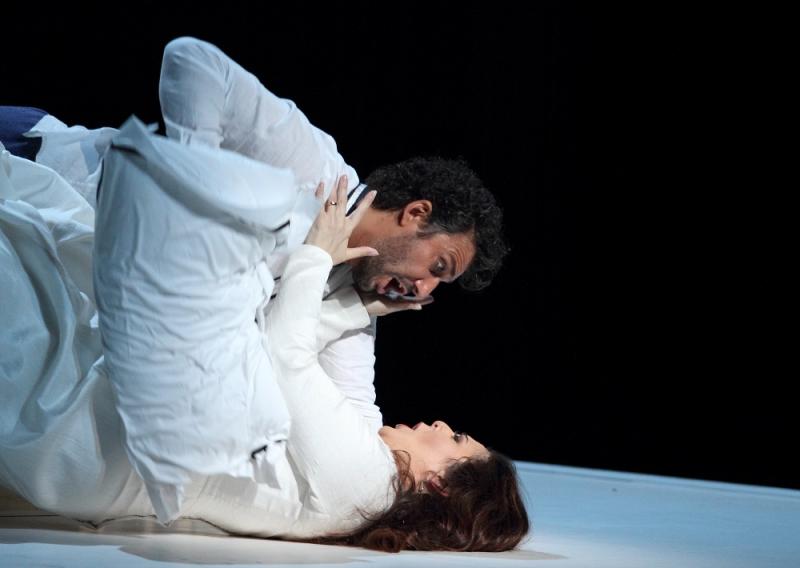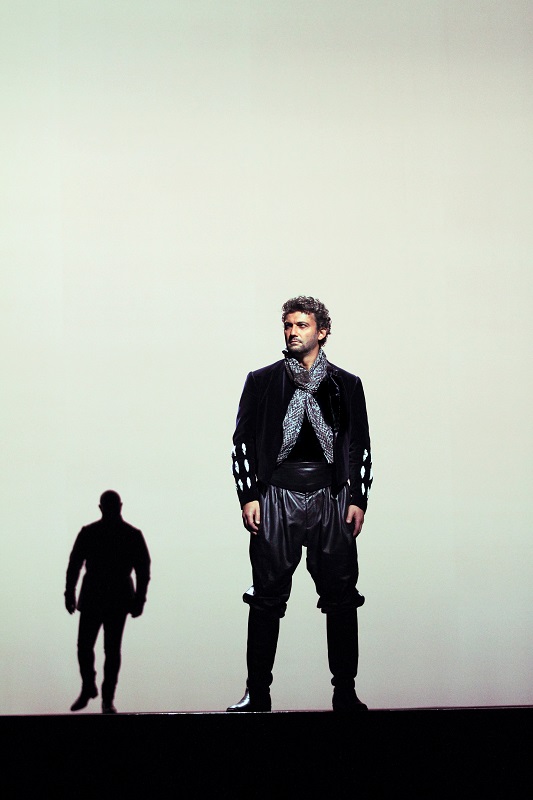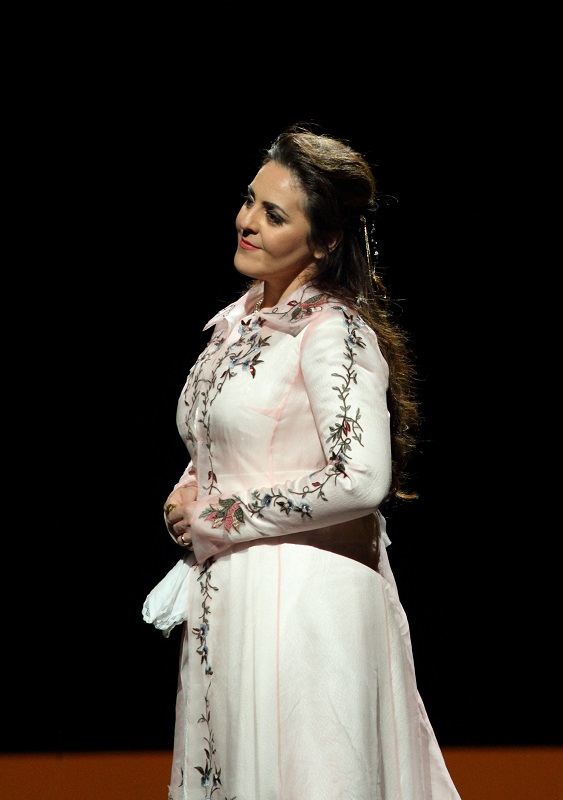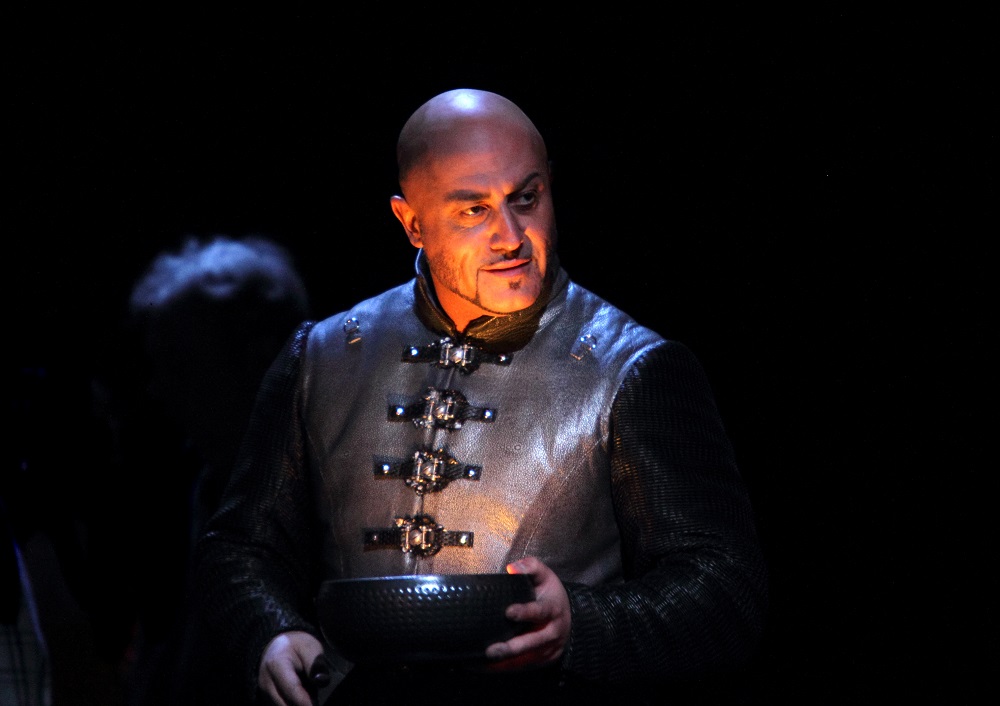Otello, Royal Opera review — Kaufmann makes a pretty Moor | reviews, news & interviews
Otello, Royal Opera review — Kaufmann makes a pretty Moor
Otello, Royal Opera review — Kaufmann makes a pretty Moor
New production of Verdi's tragedy is a trial to look at - and heaven to listen to

Recorded on disc, this cast would be extraordinary for much of the time — to look at, not so much.
The flattering look dilutes the dramatic effect, however. Less perfection needed. For you need to suspend much disbelief to accept Kaufmann (pictured below) as a man so prey to doubt about his sexual appeal to his wife that he kills her simply because of an insinuation that another man flirted with her. He is by unfair advantage a glorious man, up there with Roger Federer and Cary Grant, and masculine vulnerability is not credible in his case without some considerable effort on the director's part.
 For this Otello to be imprisoned in Keith Warner’s lifeless new production, set inside a chilly black box set, and with all the high emotions staged with perplexing physical awkwardness, does not help breach disbelief. (I noted with pleasure the special brevity to which the costumier had tailored his jerkin over his long, graceful legs.)
For this Otello to be imprisoned in Keith Warner’s lifeless new production, set inside a chilly black box set, and with all the high emotions staged with perplexing physical awkwardness, does not help breach disbelief. (I noted with pleasure the special brevity to which the costumier had tailored his jerkin over his long, graceful legs.)
In fact reasons for this Otello’s lack of self-esteem are hard to see in the production. None of Shakespeare’s suggestions are there — the racial card is minimised to vanishing point, Maria Agresta’s Desdemona is not intimidatingly gorgeous, Marco Vratogna’s bull-headed, shaven Iago is a blatant bad sort and Frédéric Antoun’s delicate Cassio is no threat to anyone.
There’s little imaginative stimulus in the setting — this Venetian colony on Cyprus has nothing of Mediterranean light, sea or sensuality, everything being starkly lit and black, with a boxy bench or two, and walls that are prone to move ponderously about. With nowhere to sit or recline, the chief singers must loll or writhe on the floor, trying to sing their high notes while prone, which always costs tone. Poor Desdemona spends a lot of time crawling, kneeling and lying in her big dresses, when it looks ridiculous. Equally ridiculous is the vast white Lion of St Mark statue that trundles across the stage for a few seconds, and is next seen in bits in Otello’s loft.
Really, the thing’s a trial to look at, and thoroughly discouraging of the fatally heated ensemble verismo required of Verdi's distilled scenes.
 But there could be no finer encouragement to the casts than Pappano, who from the first notes whips the Royal Opera House orchestra like Poseidon whipping the seas or Zeus the fates. Three hours whirl by, neatly split by one interval. What a fantastic volume of sound from the Royal Opera chorus in the opening, their stasis making eloquent contrast with the raging of Verdi’s scene-painting. Every word in the libretto seems to be reflected in the composer’s scoring, and Pappano pounces on the sparkles, birds, breezes, and the natural features that the staging chooses to ignore.
But there could be no finer encouragement to the casts than Pappano, who from the first notes whips the Royal Opera House orchestra like Poseidon whipping the seas or Zeus the fates. Three hours whirl by, neatly split by one interval. What a fantastic volume of sound from the Royal Opera chorus in the opening, their stasis making eloquent contrast with the raging of Verdi’s scene-painting. Every word in the libretto seems to be reflected in the composer’s scoring, and Pappano pounces on the sparkles, birds, breezes, and the natural features that the staging chooses to ignore.
The moment Kaufmann came ashore, trumpeting success over the Muslims, you heard a man of nobility and courage, though he had to force the volume to ride Pappano’s monster waves of brass. Later performances might show a less hesitant stage commitment to the relationship with Agresta, and to the physical embodying of Otello’s loss of mental control of his jealousy. A Kaufmann-Pappano audio recording soon, please, not video, so that he can exploit his potentially thrilling vocal characterising without the distraction of physically acting it under a bad director.
The Italian Agresta (pictured above) is intriguing. Her grainy soprano, with a spreading vibrato, sounded heavy in the first act, yet vanished to almost nothing in her lower register. Still the honesty of her Desdemona grew on me, and became greatly moving in her final scene, singing to her inconsistent vocal limits in a way that was dramatically compelling, haunted in the "salces" and achingly sad in the Ave Maria.

Vratogna’s Iago (pictured above) is a bit of a mystery in the scheme of what Pappano seems to be indicating. He dominated the stage physically, with a suitably black-hued baritone and brooding predatoriness, but barked out Iago’s part with such violence of timbre and undisguised unpleasantness that the idea of Kaufmann’s well-bred Otello being best mates with him was implausible. Some reining in would benefit all round.
Thomas Atkins sounded good as Roderigo, there is a nice slick sword fight in Act 1 choreographed by Ran Arthur Braun, and some of the chorus sopranos sound more wobbly than desirable.
- Verdi’s Otello continues at the Royal Opera House with this cast until July 10, and another cast to July 15
- The June 28 performance will be transmitted live to cinemas worldwide in the ROH Live Cinema Season
rating
Explore topics
Share this article
Add comment
The future of Arts Journalism
You can stop theartsdesk.com closing!
We urgently need financing to survive. Our fundraising drive has thus far raised £49,000 but we need to reach £100,000 or we will be forced to close. Please contribute here: https://gofund.me/c3f6033d
And if you can forward this information to anyone who might assist, we’d be grateful.

Subscribe to theartsdesk.com
Thank you for continuing to read our work on theartsdesk.com. For unlimited access to every article in its entirety, including our archive of more than 15,000 pieces, we're asking for £5 per month or £40 per year. We feel it's a very good deal, and hope you do too.
To take a subscription now simply click here.
And if you're looking for that extra gift for a friend or family member, why not treat them to a theartsdesk.com gift subscription?
more Opera
 Carmen, English National Opera review - not quite dangerous
Hopes for Niamh O’Sullivan only partly fulfilled, though much good singing throughout
Carmen, English National Opera review - not quite dangerous
Hopes for Niamh O’Sullivan only partly fulfilled, though much good singing throughout
 Giustino, Linbury Theatre review - a stylish account of a slight opera
Gods, mortals and monsters do battle in Handel's charming drama
Giustino, Linbury Theatre review - a stylish account of a slight opera
Gods, mortals and monsters do battle in Handel's charming drama
 Susanna, Opera North review - hybrid staging of a Handel oratorio
Dance and signing complement outstanding singing in a story of virtue rewarded
Susanna, Opera North review - hybrid staging of a Handel oratorio
Dance and signing complement outstanding singing in a story of virtue rewarded
 Ariodante, Opéra Garnier, Paris review - a blast of Baroque beauty
A near-perfect night at the opera
Ariodante, Opéra Garnier, Paris review - a blast of Baroque beauty
A near-perfect night at the opera
 Cinderella/La Cenerentola, English National Opera review - the truth behind the tinsel
Appealing performances cut through hyperactive stagecraft
Cinderella/La Cenerentola, English National Opera review - the truth behind the tinsel
Appealing performances cut through hyperactive stagecraft
 Tosca, Royal Opera review - Ailyn Pérez steps in as the most vivid of divas
Jakub Hrůša’s multicoloured Puccini last night found a soprano to match
Tosca, Royal Opera review - Ailyn Pérez steps in as the most vivid of divas
Jakub Hrůša’s multicoloured Puccini last night found a soprano to match
 Tosca, Welsh National Opera review - a great company reduced to brilliance
The old warhorse made special by the basics
Tosca, Welsh National Opera review - a great company reduced to brilliance
The old warhorse made special by the basics
 BBC Proms: The Marriage of Figaro, Glyndebourne Festival review - merriment and menace
Strong Proms transfer for a robust and affecting show
BBC Proms: The Marriage of Figaro, Glyndebourne Festival review - merriment and menace
Strong Proms transfer for a robust and affecting show
 BBC Proms: Suor Angelica, LSO, Pappano review - earthly passion, heavenly grief
A Sister to remember blesses Puccini's convent tragedy
BBC Proms: Suor Angelica, LSO, Pappano review - earthly passion, heavenly grief
A Sister to remember blesses Puccini's convent tragedy
 Orpheus and Eurydice, Opera Queensland/SCO, Edinburgh International Festival 2025 review - dazzling, but distracting
Eye-popping acrobatics don’t always assist in Gluck’s quest for operatic truth
Orpheus and Eurydice, Opera Queensland/SCO, Edinburgh International Festival 2025 review - dazzling, but distracting
Eye-popping acrobatics don’t always assist in Gluck’s quest for operatic truth
 MARS, Irish National Opera review - silly space oddity with fun stretches
Cast, orchestra and production give Jennifer Walshe’s bold collage their all
MARS, Irish National Opera review - silly space oddity with fun stretches
Cast, orchestra and production give Jennifer Walshe’s bold collage their all
 Káťa Kabanová, Glyndebourne review - emotional concentration in a salle modulable
Janáček superbly done through or in spite of the symbolism
Káťa Kabanová, Glyndebourne review - emotional concentration in a salle modulable
Janáček superbly done through or in spite of the symbolism

Comments
Ismene - Critics often review
I liked the inconsistency
I liked the inconsistency (generally I like inconsistency). The schoolgirlish lower register, the grainy middle, the soft piano top, united very expressively in the final act. And how do 'critics' differ from 'the audience'? I am one in the audience, as are you.
I don't understand the
It is not every day that the